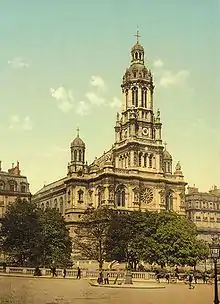Sainte-Trinité, Paris
The Église de la Sainte-Trinité is a Roman Catholic church located in the 9th arrondissement of Paris. The church is a building of the Second Empire period, built between 1861 and 1867 at a cost of almost 5 million francs.



La Trinité, as it is known, was designed by Théodore Ballu as part of the beautification and reorganization of Paris under Baron Haussmann. Exterior figures of Faith, Hope, and Charity on the church were sculpted by Eugène-Louis Lequesne. The 93 meter-long church has a bell tower 63 metres high topped by a dome. The choir is ten steps higher than the nave and surrounded by an ambulatory.[1] Also named after it are the rue de La Trinité and the square de La Trinité.
The church is accessible by the Métro (the nearby station, Trinité, is named after it) and is known internationally for its former organist, the French composer Olivier Messiaen. It was the location of Gioachino Rossini's funeral, on 13 November 1868, Hector Berlioz's funeral, on 11 March 1869, and Georges Bizet's funeral in 1875.
The church's facade served as the inspiration for the design of the Saint-Jean-Baptiste Church in Quebec City[2] and the Cathedral of the Blessed Sacrament in Sacramento, California.
Organs
La Trinité features two organs, a Cavaillé-Coll chancel organ and a Cavaillé-Coll grand organ located in the balcony. The latter instrument has been extensively renovated and expanded over the decades:
- 1869 Original construction by the Cavaillé-Coll firm
- 1871 Reconstruction and repairs by the Cavaillé-Coll firm after damages incurred during the Paris Commune of 1870
- 1901 Rebuilding by Merklin
- 1934 Rebuilding by the Pleyel-Cavaillé-Coll firm
- 1962–65 Rebuilding by the Beuchet-Debierre firm
The current specifications of the grand organ are:
|
|
|
| ||||||||||||||||||||||||||||||||||||||||||||||||||||||||||||||||||||||||||||||||||||||||||||||||||||||||||||||||||||||||||||||||||||||
Organists
The titular organists at La Trinité include
- Charles-Alexis Chauvet (1869-1871)[3]
- Alexandre Guilmant (1871–1901)[4]
- Charles Quef (1901–1931)
- Olivier Messiaen (1931–1992)
- Naji Hakim (1993–2008)
- Maxime Patel (since 1999)
- Loïc Mallié (since 2011)[5]
References
- Huisman, G. & Poisson, G. (1966) Les monuments de Paris. Paris: Hachette; p. 320.
- "Église St-Jean-Baptiste (St. John the Baptist Church)". Fodor's. Retrieved 19 November 2011.
- Smith, Rollin (1999) "Louis Vierne: Organist of Notre-Dame Cathedral". Pendragon Press
- Ochse, Orpha Caroline (1994) Organists and Organ Playing in Nineteenth-Century France and Belgium, pp. 195-96. Indiana University Press. ISBN 0-253-21423-8
- "Organistes titulaires" (in French). Retrieved 12 January 2019.
External links
| Wikimedia Commons has media related to Église de la Sainte-Trinité de Paris. |